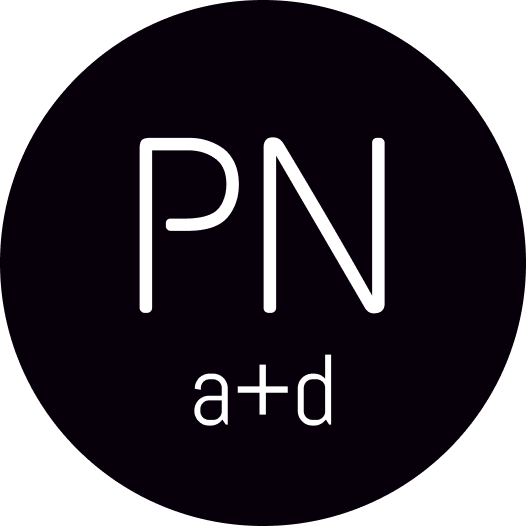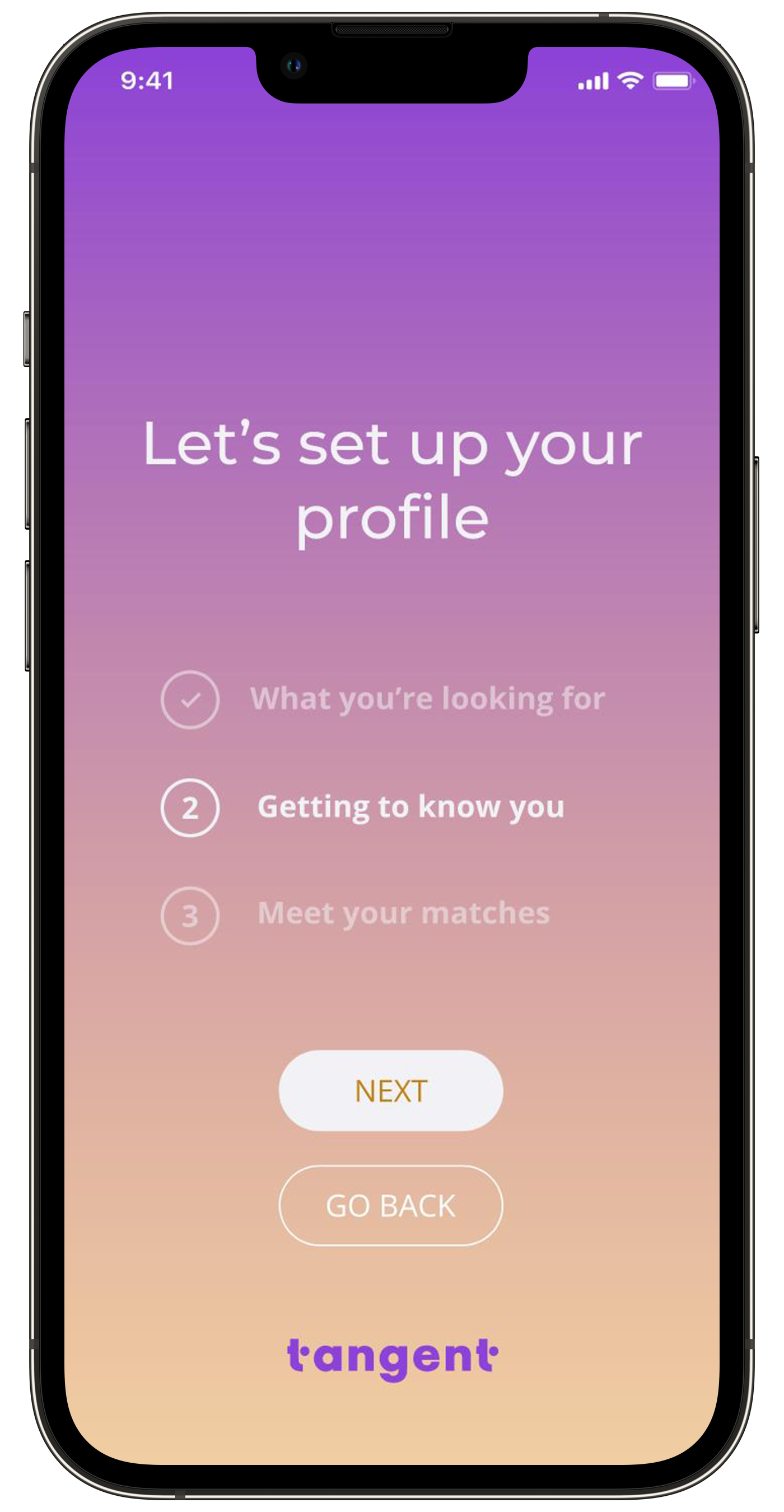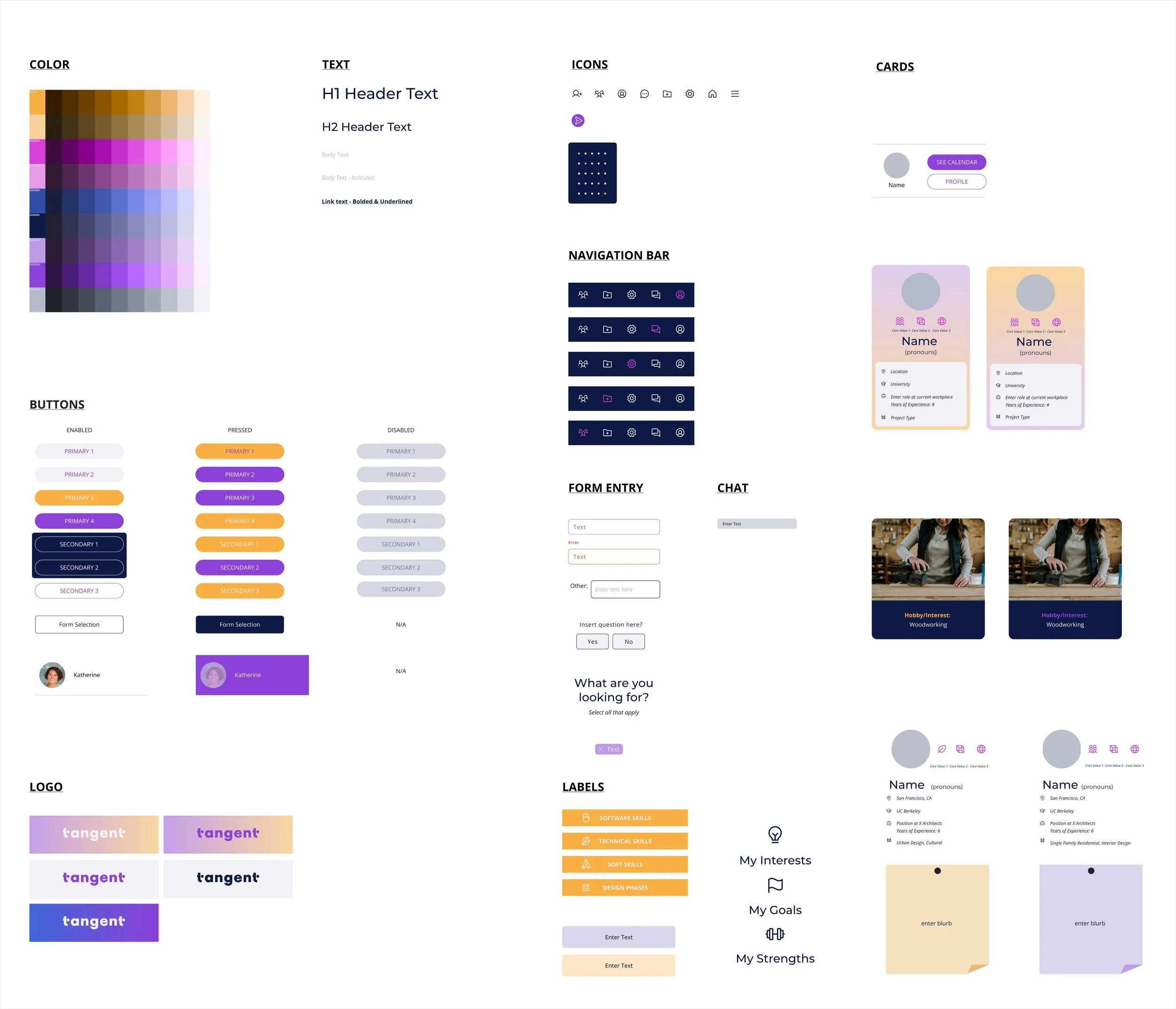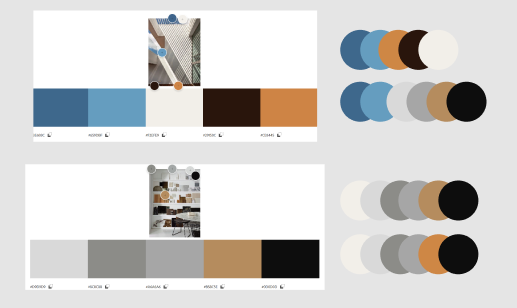
Tangent is a connection platform that helps architecture students and professionals develop successful mentorships. It facilitates meaningful connections between architects in the Bay Area, while providing the tools to help sustain and bolster these relationships.
PROBLEM
Mentorship has the potential to help architects achieve career success and fulfillment, but architects currently don’t have convenient and effective ways of finding the right mentor and maintaining those mentorships.
How can we help architecture professionals and emerging architects find meaningful and lasting connections in a way that requires minimal time and effort?
SOLUTION
Tangent is a mobile-app that helps architecture professionals and emerging architects find mentors by providing a thoughtful mentor/mentee matching system, creating opportunities to chat and connect (in person or virtually), and providing tools for mentorship structuring and accountability.
PROJECT DETAILS
Conceptual UX/UI Project
Project Platform: Mobile App
My Role: Product Designer
Time Frame: 6 months
Initial Research
SURVEYS
To better understand about sent out a initial survey to about 20 local Bay Area architecture professionals and architecture students at University of San Francisco.
Most people confirmed that they valued and wanted mentorship, but struggle to find the right person and often give up searching.
COMPETITIVE ANALYSIS
I then did a market analysis to learn about the current tools/platforms available that support architects in searching for mentorships. The existing solutions have the following limitations:
Cost barriers
Lack of flexibility with mentor/mentee choice
Lack of industry-specific matches
Inability to find the right person
User Research
USER INTERVIEWS
I interviewed 16 people (8 architecture students and 8 architecture professionals) to better understand the problems around mentorship in the architecture industry. I wanted perspectives from a diverse group of people, in order to create a more inclusive product that is addresses any barriers that might disadvantage people by gender, race or experience level.
STUDENTS
WORKING PROFESSIONALS
I created a set of questions that focused on the following topics:
How do you feel in your career at the moment? What are your career goals and how do you plan to reach them?
What are your thoughts around mentorship/Is mentorship important to you - why/why not?
If searching for a mentor or mentee, what do you look for, and what difficulties do you face?
Do you currently have a mentor or mentee? If yes, how is that going? What ways does it work/not work?
What do you expect from a mentorship?
What makes a mentorship valuable?
INTERVIEW TAKEAWAYS
All 16 interviewees that I spoke to agreed to the importance of mentorship, and it’s role in one’s career development. Here are some key insights that I discovered from the interview process:
KEY INSIGHTS
Emerging architects and junior architects value mentorships because they are nervous/insecure about embarking on their career, and want to feel supported and learn more about the profession/field in order to succeed.
Mentors feel that interacting with mentees validates their own knowledge & professional development, and improves workplace culture.
When making a connection with a mentor/mentee, the interaction should be organic and should not feel forced or transactional. It feels unethical to receive payment for mentorship.
[Mentor perspective] If a mentee reaches out to me, it feels more worthwhile to invest in them.
A strong mentor/mentee relationship results from aligned values, goals, and a similar background (race and gender).
Consistency and commitment is important in a mentorship.
Based on the information I gathered from user interviews, I developed a persona, Maya - an ambitious and passionate 25 year old architect who has dreams of starting her own practice one day. I analyzed the problem further through Maya’s empathy map & her user journey in searching for a mentor.
PERSONA
EMPATHY MAP
USER JOURNEY
Expanding and analyzing each of the user scenarios listed above, I found design opportunities that translate into product features.
DESIGN OPPORTUNITIES DISCOVERED
Match people based on aligned goals, identity, and interests
Present a few matches at a time so people aren’t overwhelmed
Allow multiple matches, so people can have different mentors for different areas
Make it a mentee-initiated platform to take the insecurity out of debating “who reaches out first?
Profiles should have a mix of professional and personal personality, so that connection feels more organic and personal
Allow people to chat before meeting to reduce awkwardness before the first meet
Calendar to show mentor availability
Tips for conversation starters and conversation guides to help goal-setting agendas
Check in on how things are going - send occasional new matches if people are unhappy with their current ones
Virtual form with local architects to help people feel less isolated and more connected/inspired
PROBLEM STATEMENT
An architecture professional in the bay area needs to connect with mentors because they need guidance to succeed in their career. However, the demandin work culture and lack of free time makes it stressful and difficult for architects to seek these relationships.
How might we. . .
. . . connect architectural professionals in the bay area?
. . . make connections easy, fun and valuable?
. . . help sustain these relationships to encourage commitment/consistency?
Insights
Minimum Viable Product
PRODUCT IDEA
Tangent is a mobile-app that helps architecture professionals and emerging architects find mentors by providing a thoughtful mentor/mentee matching system, creating opportunities to chat and connect (in person or virtually), and providing tools for mentorship structuring and accountability.
The name Tangent came from the product goals: to intersect professional journeys, encourage off-topic discussion for authentic relationships, and appeal to architects (who resonate with geometry terms).
ONBOARDING
Users are onboarded in 3 steps. They can then meet the different mentors available to them, initiate conversation and access tools to help structure their mentorship.
CHALLENGES
One of the things I struggled with was designing the onboarding flow. Asking the right questions/right amount of questions and keeping the experience enjoyable/engaging was tricky. Originally I had the onboarding questionnaire a a series of 10 questions that had multi-part answers. It felt cumbersome and long, so I decided to split it into 2 categories “What you’re looking for” and “Getting to know you” with only 5 questions each, to help keep users engaged.
I also iterated on question formats to help make the questions more brief/focused and the onboarding process more enjoyable and less cumbersome.
EARLY ITERATION
FINAL
EARLY ITERATION
FINAL
For the mentee profile and mentor profile shown below, I used colors to differentiate roles (yellow for mentor and purple for mentee). These profile designs are still in progress, see my thoughts below on how the next iteration could improve the designs:
The information at the top of the profile is what I thought would be most important for people to see about each other when looking for a mentor match. I plan to do usability testing to verify these assumptions.
The “My Interests” section is intended to create more organic connections. I might add an engagement feature for people to respond directly to a photo (which would directly take you to the chat room)
The “My Strengths” and “My Goals” section seems too long and lacks focus, I may integrate visuals or icons for a more engaging experience, and limit strengths/goals to top 2 or top 3 to help matches be more focused.
PROBLEM
It’s hard to connect with a relatable professional who has similar career goals and shared values to develop a mentorship relationship
Professionals in the architecture industry are usually busy and overwhelmed with work, which makes people hesitant to reach out for support/guidance.
There’s a lack of structure and accountability in mentorship in the architecture industry
Cost is a barrier for mentorship platforms that currently exist for architects.
Lean Canvas Business Strategy
SOLUTION
Create a platform that matches people based on their shared values, career goals, preferences for identity (gender, race, etc.)
Platform should include calendars and availability slots for meeting times.
Include tools that help structure development (professional development outline, additional resources)
Membership should be free for both mentors and mentees
UNIQUE VALUE PROPOSITION
Architecture industry specific mentorship platform that encourages meaningful relationships between professionals -Connect with like minded professionals and get access to useful resources that help guide your career journey.
High level concept = polygamous professional dating app (linked in + Bumble)
CUSTOMER SEGMENTS
Architecture students looking for guidance transitioning into the profession
Architecture professionals looking for mentorship and willing to provide mentorship.
Architects looking for an extended professional community
Early adopters would be a test group of architects with varied experience levels, from 2-3 local firms have partnerships with Tangent.
KEY METRICS
Acquisition: # of subscriptions and partnerships
Activation: # of scheduled meetings
Retention: How long they stay subscribed
Revenue: Money spent on subscriptions per month
Referrals: # of users referred
UNFAIR ADVANTAGES
Strategic partnerships with architecture firms, local organizations (AIA, NCARB, NOMA), and universities
Unique insight into the architecture industry
CHANNELS
Social media, partnerships (websites, newsletter emails)
In-person (local architecture conferences or lunch & learn sessions)
Industry-specific magazine & blog articles (Architect, Arch Daily, Dezeen, Arch Digest, etc.)
COST STRUCTURE
Design and testing
Development
Collaborating with local firms and organizations
Marketing
Customer support team
REVENUE STREAMS
Partnerships (schools, corporations, NCARB, AIA, NOMA)
Freemium Model
Advertisements
CHALLENGES
In order to create an accessible and equitable product, it was important to me that there is no payment required to join the Tangent community. My research findings show that cost was a barrier for many architects and architecture students in finding meaningful mentorships. Many people I interviewed also said that a paid mentorship felt transactional, and doesn’t help towards building organic/lasting relationships.
I spoke to a friend of mine who is a product manager to get advice on how to refine my business strategy with this goal in mind - they advised me on how I might set up my cost structure & revenue streams, and who my early adopters might be. Since one of the major difficulties architects currently face while searching for mentorship is space/time within the workplace, she advised that forming partnerships with a handful of local firms would be a good starting point. These local firms could fund their employees’ Tangent accounts, while Tangent also helps design a custom mentorship model for the firms - this would result in higher job satisfaction for employees, less turnaround, and improved work performance. More work/strategy to be done on this.. stay tuned!
Design
SITE MAP
WIREFRAMES
USER FLOWS
VISUAL DESIGN
I was inspired by James Turrell’s art installations, which invoke a sense of wonder and perplex our spatial perception. I chose to incorporate the bright energizing colors from his work to inspire curiosity and excitement for the user journey.
I extracted colors from this inspiration set to create a balanced color scheme, and developed an atomic design system for the UI design.
CHALLENGES
My earlier color scheme had a much more neutral color palette (see below). This was inspired by the material palettes and color schemes that architects are often drawn to in their work. However, I realized this color scheme was likely within an architect’s comfort zone, and didn’t necessarily feel like an “intervention” in their daily experience as I intended Tangent to be. I landed on the James Turrell color scheme above to create a more energizing and inspiring experience for the users.
























